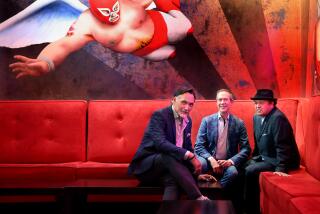Insomniac works to keep Exchange L.A. up all weekend
In late July, after playing a sold-out show at Staples Center in downtown Los Angeles, DJ Kaskade headed down the street to play an intimate after-party at a nightclub called Exchange L.A. There he electrified electronic dance music fans with an entirely different set featuring an old-school mash-up of deep house and tech house.
The scene was exactly what Exchange L.A. is becoming known and celebrated for since partnering in June with Insomniac, which produces and promotes some of the largest and most influential EDM concerts in the country, including the massive Electric Daisy Carnival. Given that pedigree, it’s notable that Insomniac has chosen Exchange L.A., which has a capacity of 1,700, to stage weekly Friday and Saturday night parties called “Awakening” and “Inception,” respectively.
“Downtown has always been attractive to me and Insomniac because it’s where dance music’s roots are. Before this music was in every Hollywood and Vegas nightclub it was sort of born in downtown L.A.,” says Pasquale Rotella, Insomniac’s chief executive and founder. “We can get more experimental downtown, we can get fresh talent and go back to our roots, not just what’s hot and buzzing.”
It’s an approach that’s proving popular with EDM fans who come in droves to see the likes of John O’Callaghan, Cosmic Gate, Emma Hewitt and Shogun. The Insomniac shows at Exchange L.A. are drawing between 1,200 and 1,500 fans each night, says Exchange L.A. co-owner Adi McAbian.
McAbian and his partners spent two years renovating the venue, which was built in 1930 and opened in 1931 as the Los Angeles Stock Exchange. The four-story Art Deco building is considered a historic landmark and provides a stunning backdrop for the trance-inducing thump of house music.
“The venue was built out and set up specifically for dance music,” says Exchange L.A. manager Anthony Smith, giving a tour on a recent Friday night while a trance duo from Netherlands called W&W; powered through a sweaty set. “I’m just excited that Insomniac came along and brought us all these amazing DJs because the venue is finally living up to its full potential.”
The sound system and aesthetic of Exchange L.A. were, in fact, a big part of why Insomniac chose to partner with it, says Rotella.
“We’re always looking for unique places to host events at whatever size, and with Exchange L.A. — with the money invested down there — it’s a world-class nightclub,” he says. “That was enough for us to put time and energy into creating something there.”
Also key to the buzz and increasing success of Awakening and Inception is a certain unpretentious, low-key vibe.
“You see some of these VIP venues and they don’t look like nightclubs, they look like restaurants with tables and sofas,” says Insomniac’s head talent buyer, Carlos Correal, who works daily on Exchange L.A. “And the people in them look like they’re getting ready to eat some food.”
With a state-of-the-art lighting system, a raised stage, a 200-square-foot LED screen and a giant disco ball, Exchange L.A. is very much a party palace. However, if you desire a VIP setting it can be found on a wrap-around, second-floor mezzanine, complete with view of the swarming dance floor and DJ booth.
“It’s great to go back to the roots of dance music and be the anti-VIP club,” says Rotella. “We still offer those services, but not in a way that interferes with the energy.”
Add that to the fact that Insomniac is producing over 100 shows a year at Exchange L.A. and you have a formula for the type of long-term curation that draws fans of all stripes.
“Different DJs and different styles will attract different people, however many of the fans begin to explore other genres,” says McAbian. “We’re developing an eclectic fan base who all share a common love for the music.”
Currently, Friday nights are devoted to progressive and trance, says Correal, but “Saturday is going to be like my mansion was in Miami where everything goes on. We have some bigger surprises coming.”
And the surprises just might keep coming, says Rotella.
“It’s definitely something we’re interested in growing. It seems to me that this could last a long time.”
More to Read
The biggest entertainment stories
Get our big stories about Hollywood, film, television, music, arts, culture and more right in your inbox as soon as they publish.
You may occasionally receive promotional content from the Los Angeles Times.







